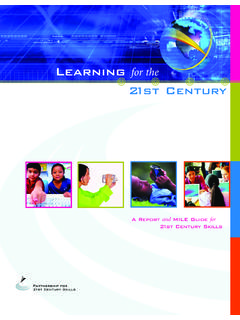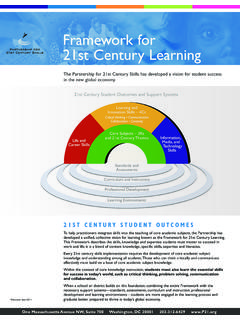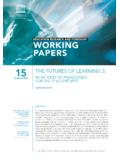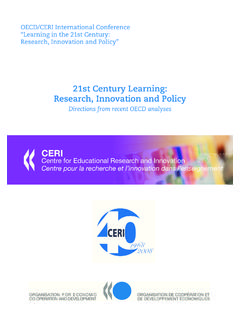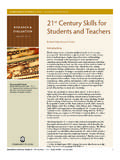Transcription of Teachers for the 21st Century - OECD.org
1 Teachers for the 21st Century Using EvalUaTion To improvE TEaChingBackground Report for the 2013 International Summit on the Teaching ProfessionTeachers for the 21st CenturyUsing EvalUation to improvE tEachingthe statistical data for israel are supplied by and under the responsibility of the relevant israeli authorities. the use of such data by the oEcD is without prejudice to the status of the golan heights, East Jerusalem and israeli settlements in the West Bank under the terms of international credits: asiapix / inmagine Jose luis pelaez, images/corbiscorrigenda to oEcD publications may be found on line at.
2 OEcD 2013 You can copy, download or print oEcD content for your own use, and you can include excerpts from oEcD publications, databases and multimedia products in your own documents, presentations, blogs, websites and teaching materials, provided that suitable acknowledgement of oEcD as source and copyright owner is given. all requests for public or commercial use and translation rights should be submitted to requests for permission to photocopy portions of this material for public or commercial use shall be addressed directly to the copyright clearance center (ccc) at or the centre fran ais d exploitation du droit de copie (cFc) at work is published on the responsibility of the secretary-general of the oEcD.
3 The opinions expressed and arguments employed herein do not necessarily reflect the official views of the organisation or of the governments of its member document and any map included herein are without prejudice to the status of or sovereignty over any territory, to the delimitation of international frontiers and boundaries and to the name of any territory, city or cite this publication as: oEcD (2013), Teachers for the 21st Century : Using Evaluation to Improve Teaching, oEcD 978-92-64-19385-7 (print)isBn 978-92-64-19386-4 (pDF)3 Teachers for The 21st Century .
4 Using evaluaTion To improve Teaching OECD 2013 AcknowledgementsThe volume is mainly based on the teacher appraisal chapter of the final synthesis report from the OECD Review on Evaluation and Assessment Frameworks for Improving School Outcomes, which was drafted principally by Deborah nusche, together with Thomas radinger, paulo santiago and claire shewbridge of the oecD early childhood education and schools Division. The analysis and case studies from countries taking part in the summit that are not represented in the oecD review were prepared by Kristen Weatherby.
5 The volume was edited by andreas schleicher in collaboration with Kristen Weatherby, marilyn achiron and giannina rech and in consultation with the summit co-sponsors, education international and the ministry of education of the for The 21st Century : using evaluaTion To improve Teaching OECD 2013 Table of ContentsIntroductIon ..9chapter 1 StandardS and governance of teacher appraiSal ..15 Policy frameworks for teacher appraisal ..16 Governance and appraisal ..17 Balancing improvement and accountability functions.
6 17 Building frameworks for teacher appraisal ..18 Reference standards ..21 Developing a shared understanding of high-quality teaching ..21 Involving Teachers in the development of professional standards ..26 Responsibility for teacher appraisal ..26 References ..29chapter 2 procedureS for teacher appraiSal ..31 Aspects appraised ..32 Instruments and information sources ..33 Classroom observation ..33 Objective setting and individual interviews ..33 teacher self-appraisal ..34 teacher s portfolio.
7 34 teacher testing ..34 Student results ..34 Surveys of students and parents ..36 Other indicators of teacher performance ..36 Improving teaching and learning through teacher appraisal ..38 Using multiple sources of evidence for teacher appraisal ..39 Using stakeholder surveys formatively ..40 Notes ..42 References ..42chapter 3 capacity for teacher appraiSal ..45 The role of education authorities ..46 The role of inspectorates ..47 The role of professional teacher organisations ..47 The role of schools and school leadership.
8 47 Conducting the evaluation process ..50 Central education authorities ..50 External inspectors ..50 School leaders ..50 teacher peers ..50 Other evaluators ..53 Using multiple evaluators ..53 Developing skills for teacher appraisal ..53 Enhancing the capacity of Teachers to benefit from their appraisals ..53 Strengthening the capacity of school leaders to conduct regular teacher appraisal ..54 Building the skills of peer evaluators ..54 Developing central expertise for teacher appraisal ..56 Notes.
9 57 References ..576 OECD 2013 Teachers for The 21st Century : using evaluaTion To improve TeachingTable of Contentschapter 4 uSing the reSultS from teacher appraiSal ..59 Formative use of Summative use of results ..63 Career decisions ..63 Salary increases and performance rewards ..65 Sanctions for underperformance ..66 Ensuring that teacher appraisal feeds into appropriate professional development for Teachers ..67 Establishing a teacher -career structure and linking appraisal to career progression.
10 68 Using teacher appraisal results to shape incentives for Teachers ..70 Ensuring that underperformance is detected and addressed ..71 The influence on teacher self-efficacy ..71 References ..73chapter 5 towardS a coherent approach to evaluation and accountability ..75 Design a coherent framework for evaluation and accountability with the student at the centre ..76 Include a balance of components, such as measures of student outcomes, system-level indicators with basic demographic, administrative and contextual information, and research and analysis to inform planning, intervention and policy development.











